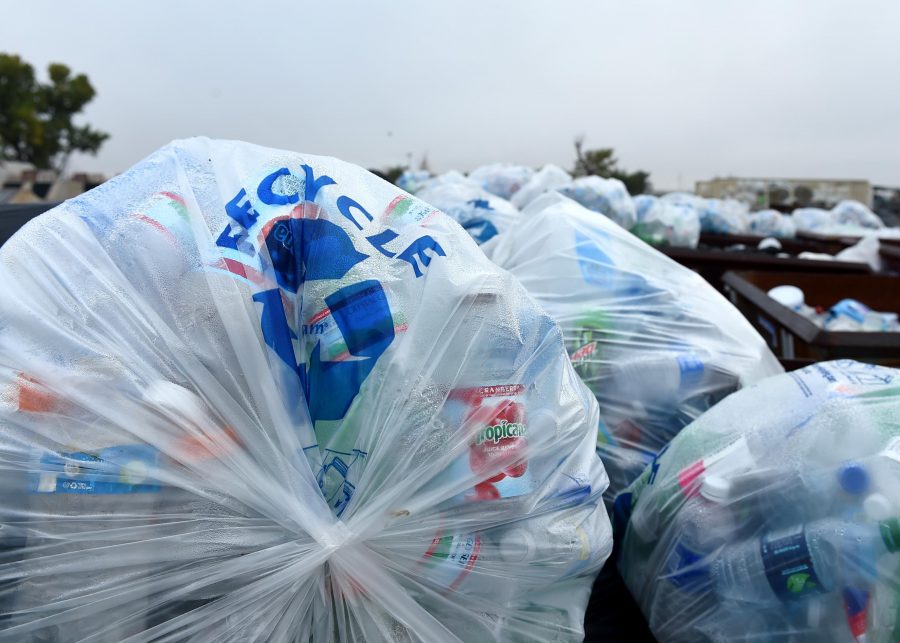California has long prided itself in being a progressive, environmentally-friendly state, but this status may slowly be slipping. Recycling in California has become increasingly difficult as global recycling markets waver, affecting intrastate recycling centers that must now deal with higher recycling costs and lower value of recyclable materials. With such a heavy hit to a core component of California’s recycling infrastructure, its sustainability is being called into question.
In the past few years, the amount of exported recyclables from California has decreased significantly. According to 2017 data released by the California Department of Resources Recycling and Recovery, also known as CalRecycle, the amount of exported recyclables has decreased in weight by 33% since 2011. Plastic scrap exports to China, which typically receives about 62% of California’s recyclables, have decreased by 99% in 2018 due to China’s recent National Sword policy which places heavy restrictions on recycling imports. These decreases are devastating to California’s recycling infrastructure. In the past, California has “heavily relied upon the export of recyclable materials from California ports” to sustain itself, exporting as much as 16.4 million tons in 2015, but with the instability in global markets, exporting can no longer be considered a viable component.
With this heightened pressure, California’s own recycling centers now face crisis as well. Between 2013 and 2018, about 40% of California’s recycling centers have closed down, according to advocacy group Consumer Watchdog. After the recent loss of Chinese importers, the state is in dire need of efficient recycling centers; but following this pattern of shutdowns we can only expect fewer and fewer such centers.
Recent developments such as these have taken a toll on the recycling infrastructure. Even as the amount of destinations for recyclable waste dwindle, the amount of waste remains high, at about 76 million tons per year in 2015 and 2016 according to CalRecycle. Those who recycle mean well, but excess materials that cannot be recycled due to inability to process due to contamination are disposed of in landfills, negating their good intentions and furthering the consequences associated with landfill disposal. CalRecycle noted that, between 2012 to the present, amount of waste deposited in landfills has continuously increased to as much as 44.4 million tons of landfill-disposed waste in 2017, about 58% of California’s total waste. With the ambitious goal set by Governor Brown in Assembly Bill (AB) 341 to reach a 75% rate of recycling in California by 2020, this trend of increasing landfill disposal and decreasing recycling, which left recycling rate in 2017 at 42%, must drastically change in order for such a goal to be achieved. The question is: how?
Both individual and state-wide changes could help combat this waste and recycling problem and restabilize California’s teetering recycling infrastructure. On an individual level, citizens can exercise the remaining two R’s of “Reuse, Reduce, Recycle” to help minimize the level of waste in need of processing. By simply being conscious of your waste and buying the sustainable products that don’t produce as much unrecyclable, non-compostable, or unusable waste, the amount of created waste can be cut greatly. Though this may seem insignificant, the reduced amount of waste by many people across the state can make an important impact in the amount of future waste. Advocating for similar changes in businesses or use of sustainable products for manufacturing and packaging helps on a larger level, ensuring a lesser chance of creating unsustainable waste.
Additionally, disposal of recyclables and other waste directly at the appropriate centers help in proper disposal of waste that may otherwise be dumped in landfills. A statewide increase in the money incentive from 5¢ to 10¢ per small glass or plastic bottle or aluminum deposited directly at a recycling center can encourage citizens to do so more. As data shows, according to Los Angeles Times, Californian citizens recycle three out of every four suitable containers, while in states like Oregon and Michigan with an incentive of 10¢ rather than our 5¢, nine out of ten are. A larger budget can also be allocated towards the reopening of new recycling centers and continued management of existing ones, ensuring easy access to them that will further encourage citizens to recycle directly.
As consumers, we can make a conscious effort to reduce the amount of waste created that is destroying California’s recycling and waste management infrastructure. Businesses and the state government can assist in this by making decisions and changes to foster an environment in which sustainable living is both easier to achieve and encouraged. Though we may not be able to achieve the ambitious 75% rate of recycling by 2020, by taking steps that mitigate the recent loss of major importers as well as the decrease in intrastate recycling centers, we can build a healthier, more sustainable California.
Image Citation: “Bags full of plastic bottles sit at the Altus Air Force Base recycling center” by Atlus Air Force, used under CC BY 2.0
